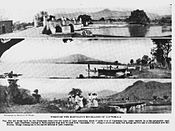Lake Amatitlán
The lake's primary inflow is the Villalobos River, and the lake is drained by the Michatoya River, an important tributary of the María Linda River. The town of Amatitlán is situated at the head of the Michatoya river. A dam with a railway on top was constructed at the narrowest point, thus effectively dividing the lake into two water bodies with different physical, chemical and biological characteristics: a north-western and a south-eastern basin.
The lake was used as a water source, for navigation and transportation, sightseeing and tourism. Until around 2010 when rapid pollution turned the lake green and the shores are full of plastic. The local population has tried to clean it but the lake remains heavily polluted and unswimmable.
History
As of 1850, the lake was used as a bathing lake and a resort area in the spring. Nearby hot springs were also popular with visitors.
Economy
In the mid 19th century, the lake was plentiful with crawfish, sardines, and other seafood. The seafood was captured and sold for the local region, as seafood was rarely imported into the area.
Pollution
Amatitlán lake's catchment area includes Guatemala City. Each year large quantities of untreated sewage, industrial waste and a staggering 500,000 tons of sediment are carried into the lake through the Villalobos River. Specifically, the lake takes in about 75,000 tons of waste from Guatemala City every year. This has contributed to high levels of pollution of the lake's water, and an accelerated eutrophication and siltation. This has seriously affected the lake's former function as a source of drinking water and irrigation, and reduced its recreational functions.
In the early 1990s under President Jorge Serrano Elias, a deal was made with a German company to use specialized machinery to clean the lake. But while the lake was already half way cleaned, corrupt political rivals staged a coup with the help of Soap and detergent manufacturers who were contaminating the lake along with other Guatemalan businesses and kick him out of office and the deal was canceled, and the lake was never cleaned and all other attempts to clean it have been futile.
In early 2015, the Lake Amatitlan Authority commission granted a contract to the Israeli company M. Tarcic Engineering Ltd. for 137.8 million quetzals, to purchase 93 000 liters of an alleged decontaminant that it would apply to Lake Amatitlán. However, after complains and legal action from scientists, academia, politicians and environmentalists who questioned the Israeli company contract, then vice president Roxana Baldetti suspended the project on 30 March 2015 and froze both the payment to the company and any decontaminant pouring into the lake. Furthermore, Baldetti was forced to resign in early May 2015 due to the La Linea corruption case.
Gallery
![]() Media related to Lago de Amatitlán at Wikimedia Commons
Media related to Lago de Amatitlán at Wikimedia Commons
-
1897
-
Early 20th century
-
Lake model in «La Aurora» zoo in Guatemala City, ca. 1925.
Notes and references
References
- ^ "Data Summary: Lago de Amatitilan". International Lake Environment Committee Foundation - ILEC. Archived from the original on 2008-05-26. Retrieved 2009-01-03.
- ^ INSIVUMEH. "Indice de lagos". Retrieved 13 July 2008.
- ^ Baily, John (1850). Central America; Describing Each of the States of Guatemala, Honduras, Salvador, Nicaragua, and Costa Rica. London: Trelawney Saunders. p. 60.
- ^ Reyna, Evelyn Irene. "Integrated Management of the Lake Amatitlan Basin: Authority for the Sustainable Management of Lake Amatitlan and its Basin". Archived from the original on 2009-01-08. Retrieved 2009-03-05.
- ^ https://www.theatlantic.com/photo/2022/10/winners-wildlife-photographer-year-2022/671722/
- ^ Global Nature Fund. "Lake Amatitlan - Guatemala". Retrieved 13 July 2008.
- ^ Rodríguez, Manuel (30 March 2015). "Baldetti suspende plan para "limpiar" lago de Amatitlán". Diario La Hora (in Spanish). Guatemala. Archived from the original on April 23, 2015. Retrieved 23 April 2015.
- ^ Valdeavellano 1897, p. 200.
Bibliography
- Anton, Danilo J. (1993). Thirsty Cities: Urban Environments and Water Supply in Latin America. Ottawa, Ont.: International Development Research Centre (IDRC). ISBN 0-88936-666-7.
- Muñoz, c.; Velasquez, E.; Aragon, Y.R. (1978). Estudio de aguas subterráneas en el Valle de la Ciudad de Guatemala (in Spanish). Guatemala City: Ministerio de Comunicaciones y Obras Publicas, Instituto Nacional de Sismología, Vulcanología, Meteorología e Hidrológica.
- Valdeavellano, Alberto G. (1897). "Orillas del Lago de Amatitlán". La Ilustración Guatemalteca (in Spanish). I (14). Guatemala. Retrieved 27 April 2015.
![1897[8]](http://upload.wikimedia.org/wikipedia/commons/thumb/f/f6/Amatitlan1897.jpg/175px-Amatitlan1897.jpg)

